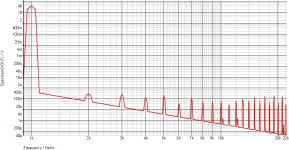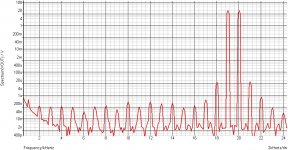First I've heard of him. I looked him up and I think it's time for a search at Amazon to buy a book or two of his.
Unfortunately, I'm neither gaunt, nor well-dressed, nor elegant, nor a cigarette smoker.
So you settle for Old Testament prophet?
Vacuphile, +100 on the Quad comments. Walker was a great designer, and wouldn't it be fun to have a 63 with multiple amps and digital delay lines.
I'm old, but not quite that old.
So you settle for Old Testament prophet?
I'm old, but not quite that old.
I did spend a few short seconds in a lift with setright once. Sadly it was also full of cult of linn followers who were handing on his every word and he was playing up to the audience. But his writing was entertaining and somewhat unique. I wonder if his review of the de Tomaso pantera is on the web. A fine car. Italian styling and american cubes.
I'm old, but not quite that old.
(give it a few)
Crikey! I had forgotten about those. They were one of my worst affectations in school.Sobranie Black Russian cigarettes

By which you mean for example the transition from crossover distortion to other nonlinearities?
Yes indeed. Our default thinking is that an amplifier's errors (not including noise) decrease continuously with decreasing signal level. We know, if we think about it more, that that's only approximately true for most modern (read: biased for efficiency) amplifiers, but we seem to always stop at the short-cut. Every time we say "0.1% distortion" we have implied that the amplifier tested is monotonic, allowing a single number description. Only JC in this section has specified that the simplification requires class A or other hot bias.
Much thanks, as always,
Chris
No. You left out a whole bunch of important engineering specs, but I'm sure that was accidental, right?
Me?
No, not me.
I'm the one asking billshruv about his approach.
Ask him what he "left out".
But, while we're on it, what's your set of "important engineering specs" that, IF met will yield audibly identical amplifiers?
_-_-
<snip>
In another case where I have more intimate knowledge, a subjective reviewer didn't detect the loss of at least an entire octave of high frequency response<snip>.
This is interesting.
IF the person listening can not hear something, they can not be bothered by it or find it good either!
Seems to me that there are a terrific number of people who due to their activities, age, injury or due to their natural physical abilities from birth who simply are physically unable to hear a whole lot of things...
...this makes it difficult for those who are unable to perceive stimuli/signals/sounds to in essence "hear what is not there".
Don't laugh, when I recorded a Lee Barber concert in my living room and played it back a couple days later, at one point my wife said something on the recording. My dog ran over to the speaker and started barking furiously. "OH NO, SHE'S TRAPPED IN THAT BIG BLACK BOX! COME SAVE HER!!!"
I'd definitely rely upon dogs...
...seems to me one dog sat for a picture in front of a wind up Victrola and sat there thinking it was "his master's voice"??
Yes indeed. Our default thinking is that an amplifier's errors (not including noise) decrease continuously with decreasing signal level. We know, if we think about it more, that that's only approximately true for most modern (read: biased for efficiency) amplifiers, but we seem to always stop at the short-cut. Every time we say "0.1% distortion" we have implied that the amplifier tested is monotonic, allowing a single number description. Only JC in this section has specified that the simplification requires class A or other hot bias.
Much thanks, as always,
Chris
The cure is obviously to have the distorsion buried in the noise even at full power, this way it will be inaudible even if its level was constant irrespective of the signal output level.
Attachments
I am confused, is that "0.1 distortion" at or about full power or maybe at 1 watt or less?
Does the distortion level vary as a function of output power in a linear fashion right down to nil output?
What's your average power level for typical listening?
Sorry, I find this confusing.
Does the distortion level vary as a function of output power in a linear fashion right down to nil output?
What's your average power level for typical listening?
Sorry, I find this confusing.
The cure is obviously to have the distorsion buried in the noise even at full power, this way it will be inaudible even if its level was constant irrespective of the signal output level.
This is often assumed but isn't necessarily true. Audibility in the presence of noise varies lots with the noise's spectrum. Critical bands, etc.
All good forune,
Chris
This is often assumed but isn't necessarily true. Audibility in the presence of noise varies lots with the noise's spectrum. Critical bands, etc.
All good forune,
Chris
This is forcibly true as the absolute level of the harmonics cant be higher than at full power, what can happen is that at 1/4 power a given or several harmonics can have the same absolute level (but not more) than at full power.
Last edited:
This is forcibly true as the absolute level of the harmonics cant be higher than at full power, what can happen is that at 1/4 power a given or several harmonics can have the same absolute level (but not more) than at full power.
I don't understand how this effects audibility in the presence of noise. ?
All good fortune,
Chris
monotonic == slope doen't change sign
pretty easy for linear outputs - small changes in slope of gm or a_v in the crossover region don't change the overall sign of the gain
most here I think are on the side of 100 ma + per output Q - so for common home systems levels they are even Class A for 60 dB SPL
distortion vs level has been measured for a while
Geddes even suggests averaging techniques to look through the limiting noise at very low levels - found a Pioneer HT Receiver with chip amps that he liked on this basis - unlikely it was Class A bias output
pretty easy for linear outputs - small changes in slope of gm or a_v in the crossover region don't change the overall sign of the gain
most here I think are on the side of 100 ma + per output Q - so for common home systems levels they are even Class A for 60 dB SPL
distortion vs level has been measured for a while
Geddes even suggests averaging techniques to look through the limiting noise at very low levels - found a Pioneer HT Receiver with chip amps that he liked on this basis - unlikely it was Class A bias output
I don't understand how this effects audibility in the presence of noise. ?
All good fortune,
Chris
What i meant is that error decrease with output level but that its harmonic distribution isnt decreasing uniformly.
Last edited:
If an amp has say 100uV output noise and that THD/IMD residuals are below 20uV how could this subnoise have an influence in the sound quality.?.
Without specifying how the noise is distributed, and where the distortion products fall on the spectrum, we can't say one way or another if 14dB is audible or not. As a separate subject, the percentage of distortion products to signal *increases* with decreasing signal level for common crossover-like distortions.
All good fortune,
Chris
Last edited:
If an amp has say 100uV output noise and that THD/IMD residuals are below 20uV how could this subnoise have an influence in the sound quality.?.
Humans can be good at extracting small signals buried in noise. For example, if you were in a crowded noisy restaurant, and somebody said, "Kill wahab" your System 1 would be more likely to score a hit for recognition and send it to System 2 for further processing than if somebody said "killer wasabe" at the same volume. At the same time your respiration, blood pressure, and stress hormones would all increase, and all those things happen fast, much before you would have a chance to become consciously aware of any possible threat. However, for non-threats, System 1 can do the same trick, extracting a signal buried in noise, if you train it. Actually, there are many many examples of that type of thing, some innate and some learned.
- Status
- Not open for further replies.
- Home
- Member Areas
- The Lounge
- John Curl's Blowtorch preamplifier part II

